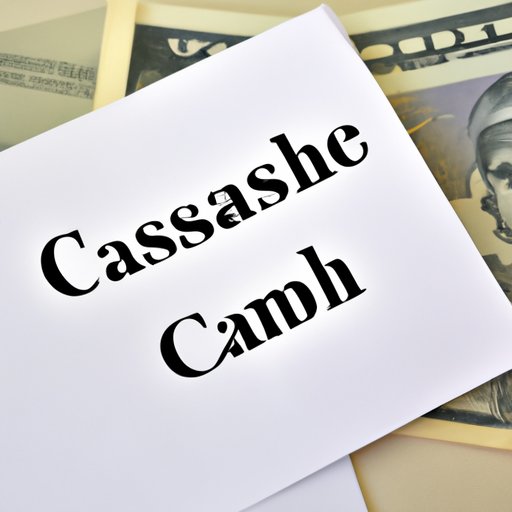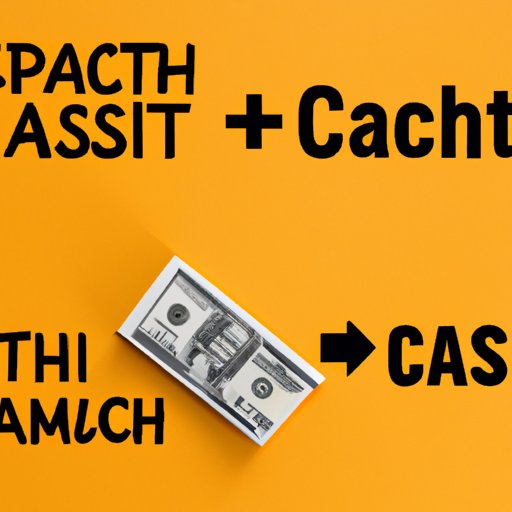
Introduction
Every year, millions of people in the United States struggle to make ends meet. For various reasons, from unemployment to low wages, many individuals and families find themselves in need of financial assistance. One of the most common forms of assistance offered by the government is cash assistance. But what exactly is cash assistance, and how much money can you get?
Understanding cash assistance benefits is crucial, as it can help people make informed decisions about their finances. In this article, we will explore various aspects of cash assistance, including benefit amounts by state, eligibility requirements, program changes over time, pros and cons, comparisons to other countries’ programs, and the impacts of politics on government programs.
A Breakdown of Cash Assistance Benefits by State
It’s important to note that living expenses and the cost of living can vary widely depending on the state you live in. Because of this, the amount of cash assistance you can receive will also vary from state to state. Generally, cash assistance is given to low-income families or individuals who are struggling to make ends meet.
The amount of cash assistance one can receive also varies between states and is often based on factors such as household size, income level, and the specific cash assistance program they’re applying for.
In Alabama, for example, the maximum amount of cash assistance a family of four can receive per month is $215, while in Alaska, the same family could receive up to $1,140. In addition, some states have work requirements that may limit eligibility for benefits, while others may not.
Typical Eligibility Requirements for Cash Assistance Programs
Eligibility requirements for cash assistance can also vary widely depending on the state and program. In general, factors such as household size, income level, and employment status play a significant role in determining eligibility for cash assistance.
For example, in California, a family of three can typically receive cash assistance if their income is less than $785 per month, while in Maine, the same family may be eligible if their income is less than $632 per month. Additionally, some programs may require applicants to have no assets or property, while others may have asset or property limits.
It’s important to note that even if someone meets the eligibility requirements for cash assistance, the total amount of benefits they receive may still be affected by their income and assets. In other words, someone with a higher income or more assets may receive less cash assistance than someone who has a lower income or fewer assets.
How Benefits Have Changed Over Time
Historically, cash assistance has undergone numerous changes in the United States. Beginning in the 1990s, welfare reform programs were implemented that placed stricter limits on eligibility and benefits.
Today, there are several different cash assistance programs offered by the government, including Temporary Assistance for Needy Families (TANF) and Supplemental Security Income (SSI). TANF is a federal program that provides cash assistance to low-income families with children, while SSI is a federal program that provides cash assistance to low-income individuals who are elderly, blind, or have disabilities.
While the benefits offered by each program may vary, the overall goal is to provide financial assistance to those in need. However, critics of these programs argue that the benefits offered are often inadequate and do little to help families and individuals rise out of poverty.
Pros and Cons of Cash Assistance
When it comes to government assistance programs, there are always pros and cons to consider. Some of the potential benefits of cash assistance include helping to provide basic needs such as food, clothing, and shelter, and offering temporary financial assistance during difficult times.
However, there are also potential drawbacks to these programs. For example, some people may feel stigmatized for receiving government assistance, especially if they’re receiving it long-term. Additionally, some programs may have limited availability, and eligibility requirements may disqualify certain individuals or families.
Despite these potential drawbacks, many success stories exist of people who have benefitted from cash assistance programs. For some individuals and families, cash assistance has provided the lifeline they needed to get back on their feet.
A Comparison of Cash Assistance Programs in the US versus Other Countries
Compared to other countries, the United States often provides fewer benefits to those in need. For example, in Norway, the maximum cash assistance benefit for a single person is over $1500 per month, while in the United States, the maximum benefit amount for an individual varies by state, with some states having benefit amounts as low as $170 per month.
In addition to benefit amounts, other countries may offer additional benefits to those in need, such as free healthcare or education. While the U.S. offers some of these benefits, they often come with limitations and may not be available to everyone who needs them.

How Politics Impacts Cash Assistance Programs
Politics can have a significant impact on government assistance programs, including cash assistance. The amount of funding allocated to these programs is often a topic of intense debate among lawmakers, and political shifts in the U.S. have led to significant changes in these programs over time.
For example, during the 1990s, the implementation of welfare reform laws led to a significant shift in how cash assistance programs were run. Today, debates over funding and eligibility requirements continue to shape these programs.
Conclusion
Cash assistance programs can be a lifeline for individuals and families who are struggling financially. While benefit amounts and eligibility requirements can vary widely between states and programs, understanding the basics of how these programs work can help people make informed decisions about their finances.
However, it’s important to recognize the potential drawbacks and limitations of these programs, including the impact of politics on funding and the stigmatization that may come with receiving government assistance.
Ultimately, if you’re in need of assistance, it’s important to explore all of your options and find the resources that can best help you. Additionally, advocating for changes to cash assistance programs can help make these programs more effective in helping those in need.





